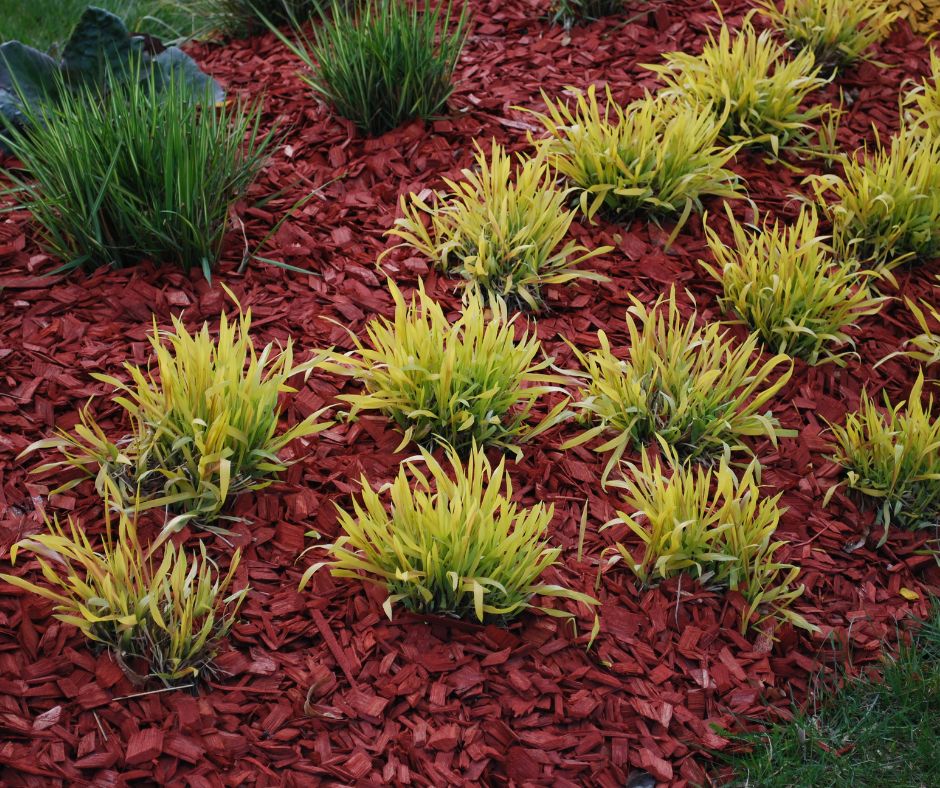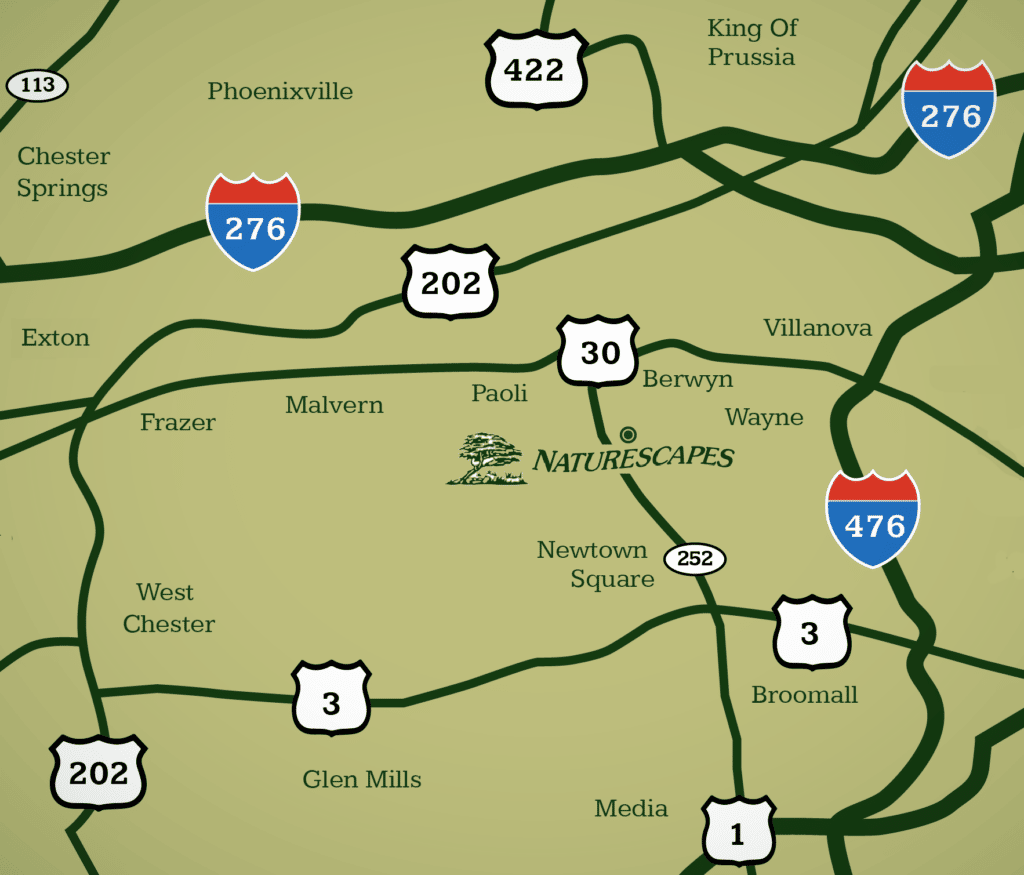 There are many beautiful gardens and homes that utilize dyed mulch. While this can add another level of customization to your landscape, it can actually do a lot of damage to your plants and soil. If you have used dyed mulch, or are thinking about using it in the future, please give this blog a read!
There are many beautiful gardens and homes that utilize dyed mulch. While this can add another level of customization to your landscape, it can actually do a lot of damage to your plants and soil. If you have used dyed mulch, or are thinking about using it in the future, please give this blog a read!
The Origins of Dyed Mulch
Dyed mulches (black, red, green, and other colors) are usually (with few exceptions) made up of recycled wood waste. This trash wood can come from old hardwood pallets, old decking, demolished buildings, or worse yet pressure-treated CCA lumber. CCA stands for Chromium, Copper, and Arsenic; chemicals used to preserve the wood. This ground-up trash wood is then sprayed with a tint to cover up inconsistencies in the wood and give it a uniform color.
Why You Should Steer Clear of Dyed Mulch in Your Gardens
This dyed wood mulch does not break down to enrich the soil as good mulch should. Instead, it leaches the dye along with the possible contaminants (chromium, copper, arsenic, and others) into the soil harming or even killing beneficial soil bacteria, insects, earthworms, and sometimes the plants themselves. These wood mulches actually rob the soil of nitrogen by out-competing the plants for the nitrogen they need for their own growth. Dr. Harry Hoitink, Professor Emeritus at Ohio State University, warns that dyed mulches are especially deadly when used around young plants and in newer landscapes.
What Naturescapes Uses
We at Naturescapes only use composted triple-shredded bark & leaf mulch. This product is 100% natural and organic that is naturally dark brown without additives. Shredded bark mulch breaks down over the course of a season or two to enrich the soil. It also increases the soil’s organic content, aids in beneficial soil bacteria, and enhances earthworm production. Being composed, or naturally aged, it actually releases nitrogen into the soil, therefore, helping plants rather than harming them.
Get a Beautiful Landscape Today
Our team at Naturescapes loves beautifying gardens and landscapes while also encouraging healthy growth and life in the plants and organisms that help our world. If you are hoping to improve the health of your garden, add more natural color and beauty to your home, or learn more about natural landscaping – contact us today for a free consultation.
Note that Naturescapes only services landscapes in Southeastern Pennsylvania (Delaware County, Montgomery County & Chester County).

Hi John,
Thank you for putting my township name on the website. I have had so many people come up to me again as they ride past my house and ask where i had it done. I send them to the website. Hoping it sends some people who really appreciate a beautiful landscape like me!!!!
Thanks,
Bet
Good info on dyed mulch. I never knew how bad it was to use!
Sally,
With all due respect, I have to disagree with your opinion on this topic. Using the correct manufacturer/supplier will prevent ANY of the above issues from happening. Yes, there are manufacturers that use the above described techniques. Are they a significant portion of the industry? No. I am with a dyed mulch manufacturer out of your own home state and I wish you were in our freight range so I could show you the difference between the “mulch” that you speak of and our mulch. This judgement (based probably off of one bad experience) applies to a very small portion of the market, even in your own state. Here are some things to consider about our Dyed Mulches:
* All of our mulches are %100 Virgin Wood Fiber which contain NO reprocessed material such as C+D (Construction and Demolition) or pallet material. This means no “CCAs” are present in ANY of our products.
* Because our raw material base is AGED, COMPOSTED, BARK, it will break down into the soil and replenish nutrients back into it. Nitrogen deficiencies occur from a application of a high percentage of FRESH, wood material.
I hope you consider these topics. Heck, if you would like, I’d be willing to give you a tour of our facility to show you how it really is done. Please feel free to write back to me or contact my organization at any time.
Thanks,
Dear AJ,
Thank you for your response to the blog we wrote about dyed mulch.
It’s refreshing to hear there are manufacturers who don’t use scrap/cca wood for their mulch.
Mine was not a blog based on one or two experiences, but on career long observations of over 40 years. Every location where I have seen dyed mulches, it has not broken down over a year or two and the pieces of ‘mulch’ were very coarse. This is not conducive to soil enrichment, which is one of the reasons to use mulch in the first place. I feel that jet black or red mulch is too artificial looking. There are many professionals who agree with me.
Again, I’m glad you don’t use recycled wood products and I have adjusted my comments to cover that possibility. Also, with the amount of red and black, and even yellow dyed mulch, in different landscapes I’m sure your business will continue to grow.
I, as a naturalist, will continue not to use them.
All the best,
John H. Fridy, Owner
In Seattle the city has so much mulch from trees it cuts they will deliver it too you. I don’t know how well dyed mulch takes to break down but the green undyed mulch they give to people here breaks down after a year or more and turns to dirt with the amount of rain we have. This undyed product does not last as long as cedar bark or fir and cedar mixed bark mulches. I have found in the ground layers of bark mulch while replacing a fence that people had put different things down over the years and the bark mulch still existed in the ground. Where as the undyed material breaks down and begins to grow weeds.
I purchased some dyed mulch material today from Lowes that came from WI. I don’t like the look of it. The size is much larger and has a lot of sharp pieces of what is clearly wood and appears to have no bark whatsoever noticeable in it.
I am planning on returning it tomorrow at 2 dollars a 2cf sack and getting bark mulch that has a much smaller size at the local QFC grocery for only 50 cents more. Because looking at it I just don’t feel it is going to be as desirable in the end and think it will ultimately break down faster too thought it may take longer than the standard green mulch the city will deliver.
There is also a lot of info about termites and mulches. I know some people find carpenter ants after getting bark delivered sometimes. They may even have a symbotic relationship here with the below ground termites. Termites will even eat treated fence posts below ground here at some point. One of the thoughts is you may attract termites if you have too much mulch. However in Texas where I am sure they have above ground type they place a board across the bottom of the fence along with some hardware cloth too to stop animals. But the board lines the bottom of the pickets and touches the ground and allows the termites to have something to eat. They change it out after so many years. We do not build them that way here as our termites only live below the ground or in a stump or dead log.
One more thing we see here. The landscapers that worked on this yard had material company deliver a type of compost/mulch that is fine in size. They put it down with a hose about 3″ sometimes 4″ or more. This not only stopped weeds from growing it stopped some of the plants or bulbs in the ground from reaching the surface. I believe it is equivalent to this product link below. This material has become popular here and does seem to keep weeds down for sometime but really without a weed barrier material nothing is going work as well for as long as it could.
Fortified Mulch
Half fine bark & half compost – used for top dress in lieu of bark. Compost adds nutrients & a dark color.
http://sunsetmaterials.com/bark.html
This is not a difficult issue to figure out. In fact, it’s a no-brainer. I’m not in the landscaping or any related business at all, but common sense tells us, plants are living things (just like humans)and putting poisons (e.g. ciggarettes) and unnatural things into our bodies will either make us very very sick or kill us, like this dyed mulch business. I used to take care of the lanscaping at our residence with natural mulch and about 15 years ago our neighbors started using the colored/dyed stuff. So hubby wanted to take that route because it looked very nice (and I agree on that point.) We’ve used the red and the black mulches for years and all I can say is, we have replaced so many plants, not of old age and not of disease, common denominator is the dyed mulch! Simple.
Interesting. I was thinking about putting red mulch in front of my mailbox.
Most reputable or well known companies do not use garbage, construction, or pallet wood in their mulch. It is usually debris from the lumber industry, BUT the dyes used are somewhat of a mystery. Although they will claim, officially, the dyes are non-toxic and no oils or petroleum products are used, I have yet to find one that will disclose the exact ingredients used in the dyes.
For example, Scotts Earthgro Color Advantage. Scotts reps state the dyes are made from proprietary ingredients (a secret recipe) and are the same type of water-based ingredients used in the cosmetics industry, but reps refuse to give details. They go on to say since cosmetics are “safe” and non-toxic, you can safely use these dyes in your vegetable garden.
But since they will not disclose the exact ingredients, and since we can almost be assured it’s not organic and can have GMOs, I would NEVER use these types of mulches in any area where I grow food or where it can leech into my soil. I have only used some sparingly in potted ornamental plants in the past, but have stopped doing that too.
Even if the dyed mulch does not have CCA it still has coloring added and leaches into the ground which can’t be good for the soil.
My town just put it down in our park and my gardening group removed it all from our gardens. The dye looks absolutely horrible with plants and I don’t understand any real gardener using such a product. Why would you want an unnatural ground cover when natural is always best for our Earth.
Today I had mulch delivers n applied. I asked before delivery whether it was dyed or not n told not . But after it was down n upon further inspection I noticed infact it wAs dyed n even had pices with nails in , it actually looked like decking that had been run through a chopper! I am furious because I just planted several new rose bushes n honeysuckle . I too am a naturalist n always want to enrich our soil not violate it! I feel like asking the landscaper to return n remove the nine yards I paid 500$ !!!